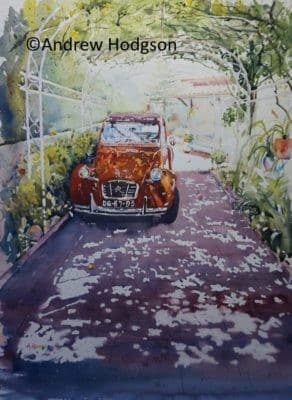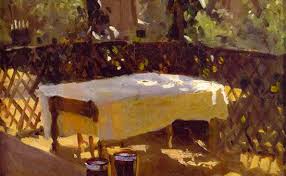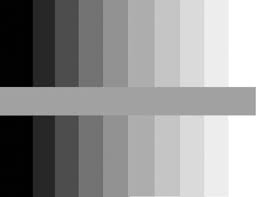Watercolour Shadows

Good shadows are essential in paintings, they are what brings your painting to life, they give the illusion of form and show the direction of light.
It had ‘bugged’ me for a long time that when looking at shadows it was often rather difficult to see the colour of the shadow, I had read about cool light giving warm shadows but that didn’t quite seem right when i looked at shadows, so i knew that I would have to understand the science of shadows to understand what I was actually seeing.
Below you will see all the information I compiled during my search for answers.
There is a lot of information out there and a lot of it did not lead me to the answer.
Finally I reached my destination, if you go the bottom of this page you will find two great videos by Marco Bucci,
‘Ambient Occlusion (and Ambient Light) for Painters’
Thank the lord I finally, just about understand what is going on with shadows.
This subject can get a ‘lot’ complicated,
however in the meantime please remember this; a simple mix of purple ( ie ultramarine blue and alizarin crimson or cobalt blue and rose madder) have worked for me as a shadow (glazed over the area where a shadow is needed) in most cases for many years.

The essentials of a good shadow are:
- The correctly drawn shape,
- The correct tonal value,
- The correct colour,
- Include bounced light.
Cast and Form Shadows
There are basically two types of shadow,
Cast shadow- this is the shadow cast by the object.
Form shadow – This is the dark side of the object.



Ambient Light
Also known as Reflected / Bounced Light, indirect light, diffused light, reflected light.
Light found in shadows.
Within the shadows there will also be reflected colour from the bounced light. The higher the sun , the more reflected light there will be in the form shadow.
Not only does the light bounce and show in the ‘form’ shadow
light from the object can be bounced into the ‘cast’ shadow

Blurred Shadow Edge
A shadow’s edge will be more blurred the further it is from the object



Noon - Short Shadow
Midday shadows will be shorter
Early or Late - Long Shadow
Early or late in the day gives long shadows


Darker nearer
In general the cast shadow will be cooler and darker nearer the form object.
Noon shadows are more colourful
- Midday shadows are more colourful than shadows early or late in the day.


Strong Light -
Strong Shadow
The stronger the light the stronger the shadow.
Warm Light = Cool Shadows
In general it is said that warm light produces cool shadows and cool light produces warm shadows.
To be more accurate it should be explained that it is not only the light source i.e. the sun that affects the shadow colour, but also the secondary (ambient) light source which in landscape is generally the colour of the sky which also affects the shadow colours, this make more sense.
and is further explained and discussed on the two following websites.
http://www.paintingvideos.net/painting-lessons/cool-painting-techniques

Drawing the shadow
Light travels in straight lines, you need to imagine where those lines would hit the surface, using one point perspective.
Shadow Colour
The true colour of the shadow depends on three things,
- the main light source, i.e. the sun.
- The ambient light source ie the blue of the sky.
- the local colour of the surface, i.e. the grass or the apple.
- the bounced light, i.e the cows belly will look a green shade.


Two Light Sources
In the landscape there will be in general two light sources,
- A strong Direct light – The colours hitting the subject, for example a warm yellow light from the sun
- A weak Ambient Light -for example a cool blue light from the sky.
Local Colour
The most important thing to get right is the tonal value in a shadow but also the
- Chroma
- and Hue
The local colour of the surface without the shadow cast upon it, in this case it would be the spring green.




Shadow Tone
The tonal value ie the dark or lightness of the shadow is extremely important in many cases.
‘Simultaneous contrast’ is the name given to the illusion that one tone next to another can trick your brain into seeing an incorrect tonal value , due to the placement of the value of a neighbouring tonal value.
As seen on the top left, the grey horizontal line across the middle actually has the same tone from one end to the other, however our brains percieve the strip to be lighter on the left than the right due to the vertical tonal strips behind it.
Therefore it can be useful to check the correct value with a simple tonal value checker as seen left.
The bottom one is simply a piece of card with a hole in it , the card isolates the colour allowing you to see the currect value/ colour.
This video is fantastic by Paul Foxton if you want to understand the importance of ‘simultaneous Contrast’
Great News!
Watercolour is different from other mediums, for shadows we can simply glaze over the local colour with a simple wash.
A shadow is simply a darker version of the local colour on which the shadow is cast.
Having searched the internet for the key to watercolour shadows I find these alternatives the most consistent.
—————————–
- Use the local colour Hue and bring down the Chroma.
- Use a cooler analogous colour (i.e. it’s neighbouring colour on the colour wheel) so for red you would move towards violet. this technique keeps your shadows bright.
- Another approach is to add the complimentary colour.


Paul Foxton – Oil Painting Shadows
I found this very interesting, although it is a different medium much of the theory also belongs to watercolour.
Paul is a fan of the Munsell colour theory and practise and disagrees strongly with the common use of complimentary colours to make shadows.
form shadows are discussed at around the 1hr mark.
( The New Munsell Student Colour Set (with 12 packs of Munsell Chips ) 3rd & 4th version include glossy value scale)
….and here they are at last the best two videos on the internet explaining how shadows work by Marco Bucci.
……NOW I CAN SLEEP!
Gary Tucker
An excellent demonstration of shadow painting.

What your Shadows Have Been Missing.
An excellent article from American Watercolor Weekly, by Brenda Swenson showing a step-by-step demonstration of painting shadows.
